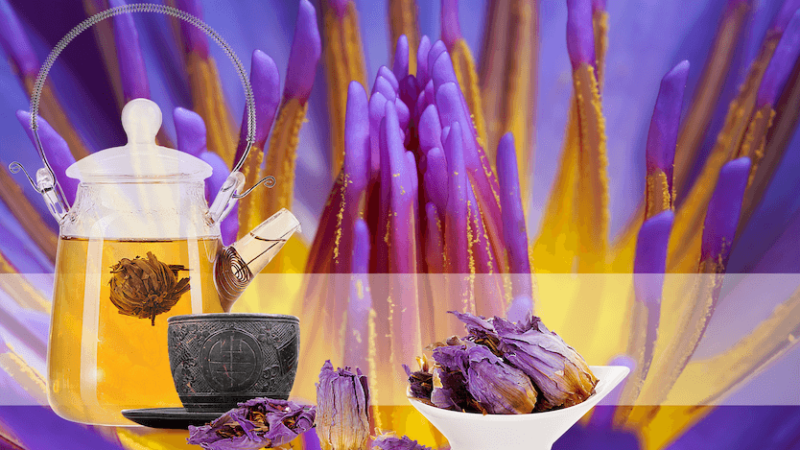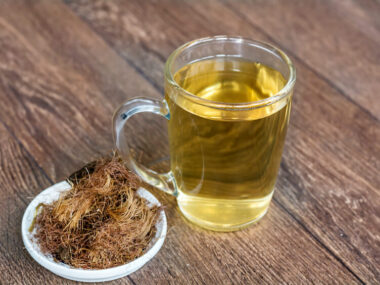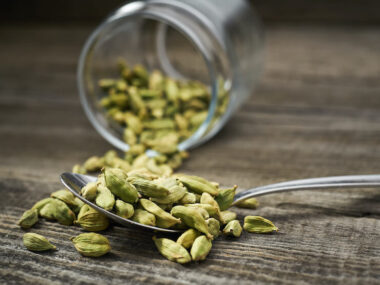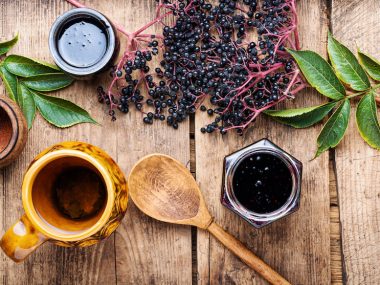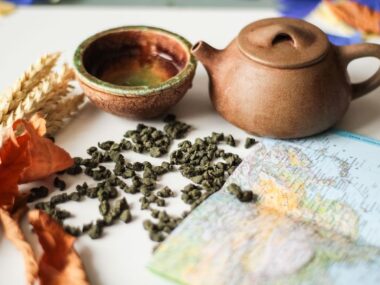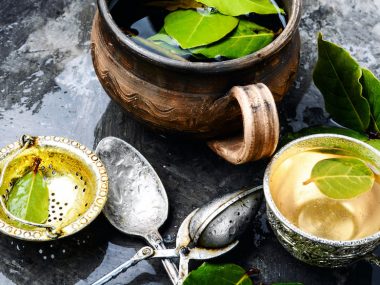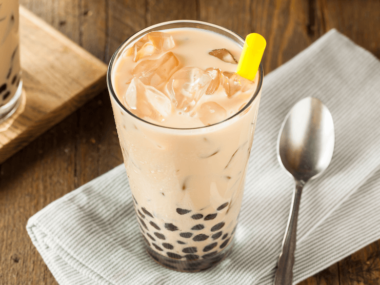Don’t let the “blue” fool you! There’s more to this tea than its lack of blue coloring. When they say blue tea relaxes, they weren’t kidding with this one!
Table of Contents
What Is Blue Tea?
Blue Tea is not a true tea but rather a tisane made from a blue lotus flower (Nelumbo nucifera.)
When preparing and drinking tea made from this flower, many claim that its aroma is floral, and the flavor is akin to beets with a vegetal, earthy taste and a subtle hint of anise.
Is Blue Tea Legal Or Illegal To Consume?
Those living in Louisiana cannot legally drink or use any form of the blue lotus plant because it’s illegal. The FDA has not approved any form of consumption of it either. In fact, some countries ban its use because of the blue lotus tea effects (psychoactive.) The U.S. military prohibits troops from using blue lotus in any form because of its effect on the central nervous system.
Why so? Because the two naturally occurring compounds in the blue lotus plant called apomorphine and nuciferine affect the part of our brain that releases dopamine (our “feel-good” hormone.) This can create a euphoric feeling. Because of this, the FDA refuses to approve its use. As a result, you won’t find blue lotus tea being sold in stores or through reputable online shopping sites. Herbalists and dispensaries, however, sell dried blue lotus flowers/leaves to make tea with.
Blue Lotus Flower Tea vs. Butterfly Pea Flower Tea
There are actually two “blue teas” in the herbal tea world that often get confused with the other. Blue Lotus flower tea is one, while the other is made from the Butterfly Pea flower.
| Blue Lotus flower tea (aka “Blue Tea”) | Butterfly Pea flower tea (aka “Blue Tea” or “Blue Matcha”) |
| Made from: Nelumbo nucifera | Made from: Clitoria ternatea |
| Color: dusky yellows/browns | Color: vibrant blues/purples/fuschia |
| Taste: fruity, floral, earthy, vegetal, anise | Taste: earthy, vegetal, grassy |
History Behind The Blue Lotus
This lotus has been revered as sacred because of its symbolic stance among various cultures. The use of blue lotus dates thousands of years back and had a cult-like following among Egyptians who worshipped various parts of the flower.
For the past 7,000 years, Asians have cultivated the blue lotus not only for its food value but for medicinal purposes. Although it is unclear which culture was the first to drink blue tea from this flower, it has continued to be consumed as a medicinal herb for various ailments.
It wasn’t until 1787 that this flower was seen for its horticultural value rather than symbolic. Sir Joseph Banks brought the blue lotus into mainstream gardening as an herb. The viability of the blue lotus for storing and using parts of it for medicine is astonishing. Seeds will keep up to 1,300 years while the rhizomes keep for 50 years or so.
What Does Blue Tea Taste Like?
Tea made from the blue lotus (blue tea) isn’t what most envision. It’s not blue colored at all but is a yellowish-brown color. Typically dried blue lotus flowers are steeped in hot water for a very long time to achieve any type of body to the drink. Its aroma is floral, and the flavor has a fruity overtone with underlying vegetal, earthy flavors with a slight anise finish. Since this tea is not a true tea, it does not contain any caffeine.
When Should I Drink Lotus Leaf Tea?
We cannot recommend consuming this tea because of its mind-altering abilities. However, should you choose to consume this tea, great caution should be used when sourcing it. Consumers in search of blue lotus tea may be met with unexpected ingredients to enhance the tea’s side effects which could turn out to be harmful or even fatal.
This tea should never be consumed before or during driving, operating machinery, or being in a situation requiring your full attention (such as caring for someone else, studying, cooking, etc.)
What Is Blue Tea Good For?
Although we are not professionally qualified to recommend the consumption of blue lotus tea, we can tell you that research indicates this tea has numerous medicinal and health benefits. Traditional medicine, Ayurvedic and Eastern medicine practitioners rely on the blue lotus plant to treat inflammation, diarrhea, cough, smallpox, nervous tension, skin problems, vomiting, and much more.
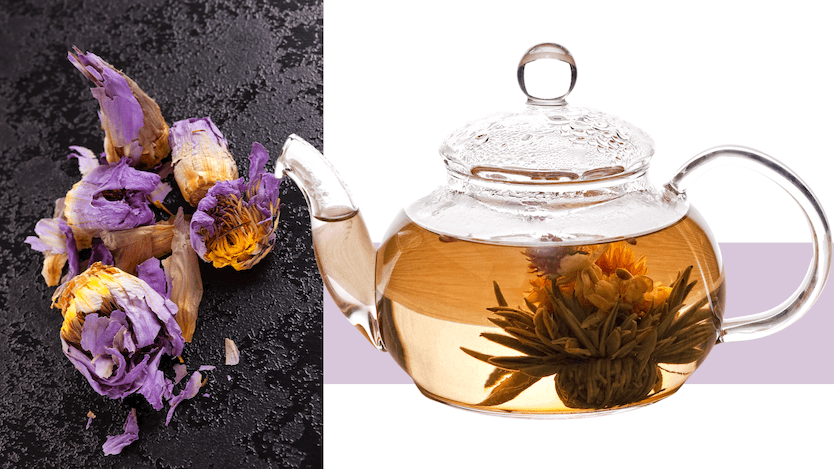
Fights Against HIV And Other Viruses
Constituents present in the plant, such as aporphine, benzylisoquinoline, and bisbenzylisoquinoline, have been found to fight HIV and Herpes Simplex Type I. To further ward off viruses, compounds in the blue lotus were found to prevent the immune system from being attacked by fighting any production of cytokines which are immunity antagonists.
Indigenous Medical Treatments
Ayurvedic, Chinese, and folk medicine treatments have often included the blue lotus to treat numerous ailments and conditions. Rudimentary forms of blue lotus teas were made by boiling the whole plant, the rhizomes, leaves, or just the flowers. The concoction is said to benefit drinkers with controlling diabetes, losing weight, relieving diarrhea, reducing fevers, and more. Emulsions were also made as topicals for skin conditions.
Relaxes
Those who do choose to drink blue lotus tea do so at their own risk. Scientific data proves that a euphoric high comes from consuming any form of the plant. The act of sitting and enjoying a cup of tea in of itself is relaxing and soothing. However, the blue lotus plant contains apomorphine and nuciferine, which has a direct effect on the central nervous system with a sedative effect that can be psychotropic.
How To Make Blue Lotus Tea
Because blue lotus loose leaf tea is not readily available in the retail market and the FDA disapproves of its consumption, we have included a few other safe “blue tea” recipes to enjoy in lieu of a blue lotus tea recipe.
Blue Cornflower Tea
Here’s what you’ll need:
- 4 cups of water
- 2 tablespoons of loose-leaf Earl Grey tea with blue cornflowers
- ¼ tsp. Vanilla extract
- ¼ cup Cream
- Tea strainer
- Teapot or teacup with cover
- Electric Kettle
Instructions
- Pour the water into the electric kettle and warm it until it reaches 160-180 degrees (F.)
- Place the loose leaf tea in the tea strainer and drop it into your teapot/teacup.
- Pour the hot water into the teapot/teacup.
- Tip: Bathe your teapot/teacup with hot water to pre-warm them.
- Add the vanilla to the teapot/teacup and allow to steep for 4-5 minutes.
- Tip: Use pure vanilla for a sweeter flavor.
- Pour cream into your teacup.
- Tip: Half and Half is good, but heavy cream is even better.
- Pour the hot tea into the cream in your teacup and stir.
- Enjoy!
Blueberry Tea
Here’s what you’ll need:
- 1 cup of blueberries
- 4 tablespoons of loose leaf tea (green, rooibos, or oolong)
- 6 cups of water
- Tea strainer
- Teapot or teacup with cover
- Saucepan
- Filtered water
- 1 teaspoon of honey
Instructions
- Fill the pan with the unfiltered water and bring to a boil. Turn the heat down.
- Tip: Fresh blueberries work best.
- Add the blueberries to the water and simmer for 15 minutes. Remove from heat.
- Tip: While the blueberries and water are heating, use a fork or potato masher to mash up the blueberries to release the sweet juices.
- Fill the tea strainer with the loose leaf tea and place it into your teapot.
- Pour the blueberry water into your teapot and allow to steep for 5 minutes.
- Pour the blueberry tea into your teacup. Add honey to sweeten.
- Enjoy!
This “Blue Brew” May Not Be For You
Although the medicinal benefits of blue lotus tea may seem to be of value, one must also consider the harmful side effects this tea can cause. Take heed when the FDA has not approved something and when other countries (and Louisiana) ban any use of the blue lotus.
